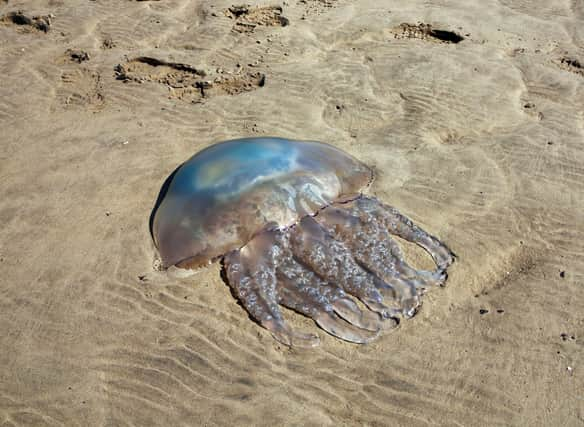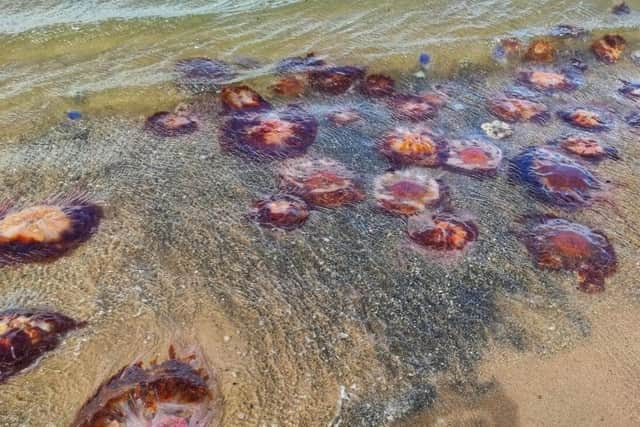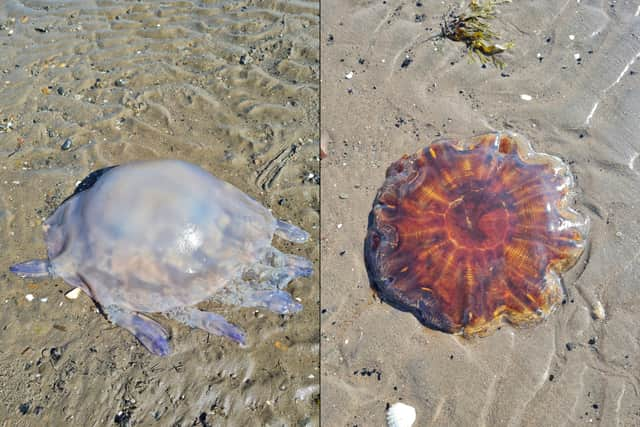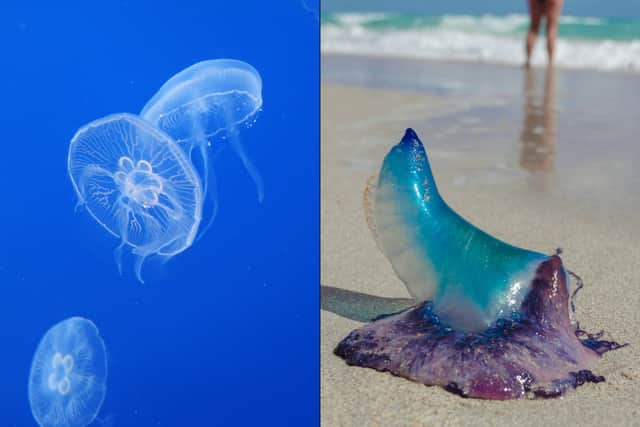Why are there so many dead Jellyfish on the beach? Scots beach called a ‘Jellyfish graveyard’


If you like long walks along the beach then be prepared to have the ambience interrupted by mass quantities of dead jellyfish littered all over the shore. As disturbing as the picture can be, however, don’t despair over it too much. As Green Matters reports:
“Jellyfish beach themselves somewhat regularly, though seeing flocks of them, completely lifeless, is generally a shocking scene nonetheless.
“But, don’t worry — it isn’t a sign of an apocalypse.”
Advertisement
Hide AdAdvertisement
Hide AdMuch like ourselves, what the Jellyfish are being affected by are “current events” (more on that later). Although we are now entering Autumn, a heatwave is looming over the United Kingdom and this Summer several beaches in Scotland saw reports of huge clumps of dead Jellyfish on their sands.
Last month, Portobello Beach in Edinburgh was teeming with the dead coelenterates, as was evidenced by Niomi Fox who shared her photographs of the scene to Edinburgh Live. She told them:
“I’ve been living in Portobello for 5 years now, and I’ve seen a few smaller jellyfish washed out to the sand before, but they were tiny. The beach looks like a jellyfish graveyard. They are huge, and lots of people are coming to see them.
“The pictures don’t do it justice, the diameter of most of them is about 60-70 cm.”
Ayr beach on the southwest coast of Scotland has also received hundreds of the marooned marine life. The Ayr Advertiser also notes that ‘experts’ warn “not to go near or touch the jellyfish as they can still give off painful stings, dead or alive.”
For your safety and information, here is everything you should know about why jellyfish beach themselves, how dangerous they are, if they can be saved, and what types wash up on Scottish shores.


Why are there so many dead Jellyfish on the beach?
As brainless creatures with no fin-based propulsion system, Jellyfish largely spend their lives drifting wherever the sea current takes them. Sadly, however, this is their downfall. According to Live Science, the bell-shaped beauties have a type of rigid “sail” that allows them to float and emerge from the water. It is useful for food collection and travel but it also may cause full colonies to be washed ashore.
Beach Stuff UK explains: “They seem to beach easily, sometimes in large numbers, when a strong wind or tide carries them in the wrong direction.
Advertisement
Hide AdAdvertisement
Hide Ad“Their sail means that they are good at catching the wind but they are not able to change direction or swim for themselves and so are helpless if they get taken towards the shore.”
Jellyfish are more abundant in Spring and Summer as, at this time, they arrive in the warmer UK waters “to feed on plankton blooms, eggs and larvae of fish, and crustaceans” according to Country File.


Are the Jellyfish dangerous?
The Marine Conservation Society tells us that most jellyfish sting (some severely) but it is rarely if ever lethal. They recommend the ‘museum exhibition’ approach i.e., look don’t touch. A notorious stinger, however, is the Portuguese Man o’ War - a closely related specimen.
According to the National Oceanic and Atmospheric Administration: “The Portuguese man o’ war is recognized by its balloon-like float, which may be blue, violet, or pink and rises up to six inches above the water line.
“While the man o’ war’s sting is rarely deadly to people, it packs a painful punch and causes welts on exposed skin.”
If you’re asking yourself: what should I do if I was stung by a Jellyfish? The NHS reassures us that most stings can be remedied by first aid but you should go to hospital if you have “severe pain that is not going away” or if you were “stung on your face or genitals”.
Can we save beached Jellyfish?
Discover Wildlife reports: “When stranded on a beach and exposed to the wind and sun, jellyfish dehydrate, so don’t survive for long.”
Some estimate that the creatures can survive for as long as 10 hours after being washed ashore but, as they are composed of 95% water, their ability to survive out of the water for any extended period has little guarantee.
Advertisement
Hide AdAdvertisement
Hide AdBeach Stuff UK adds: “A jellyfish breathes by taking in oxygen from the seawater through its skin so as soon as it is on dry land it can no longer live.”
If you find one on the beach that you think could be saved, do not touch it with your bare hands. Some sources recommend transferring the specimen, with rubber gloves, into a bucket with saltwater and - if the tentacles appear to react - it is alive and can be returned to the water.
However, this is largely accepted as the exception and not the rule. It is generally advised we simply avoid the specimens and respect their natural life cycle.


What types of Jellyfish appear on Scottish beaches?
Many sources concur that the Moon Jellyfish is the most common to appear on UK beaches. The Wildlife Trusts reports: “These are the most common jellyfish in UK seas and often wash up on our beaches.
“Around the size of a plate, they are recognisable by the four circles visible through the translucent white bell.
“You can usually see these jellyfish floating just below the surface of the water.
“Moon jellies have short, delicate tentacles that hang down from the sides of the bell.”
The BBC reports that 2023 has been a “bumper year” for Jellyfish sightings in Scotland. They said: “Different kinds of jellyfish have been seen so far, with reports of Moon jellyfish in north east Scotland, Compass off the west coast and Lion’s Mane around central and south Scotland.
Advertisement
Hide AdAdvertisement
Hide Ad“All three species can sting and people are advised not to touch even those found dead on beaches.”
Jill Thomson, veterinary manager at Scotland’s Rural College, added: “Jellyfish are a great indicator of change in our ocean, but we need more reports of them to fully understand our changing seas.”
Comments
Want to join the conversation? Please or to comment on this article.
